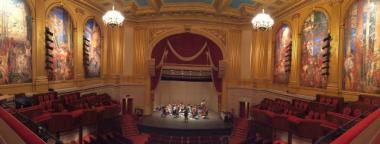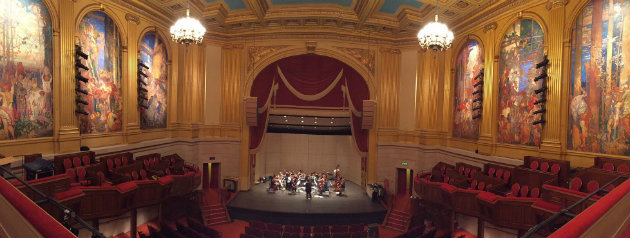
The (New) Sound of Music in Herbst
At the re-dedication last week of the War Memorial Veterans Building, which has been closed for a two-year-long seismic retrofit project, all ears were on the sound in the restructured, spiffy Herbst Theatre, the city's premier 900-seat multi-purpose music hall.
And then Stephanie Blythe launched into the most powerful a capella "The Star-Spangled Banner" I have ever heard, and the sound was just sensational. This happened without an acoustic shell that will be used for chamber music, so what the acousticians have accomplished is phenomenal.
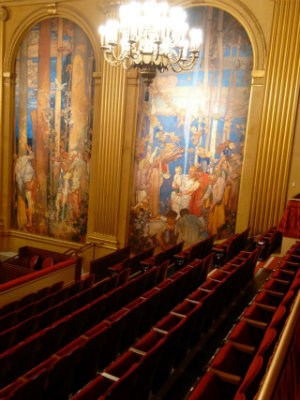
Former S.F. Symphony Executive Director Peter Pastreich has been instrumental long before the retrofitting in the project to improve the sound, and he recruited key allies to the cause. Pastreich told SFCV:
The many changes in the hall were recommended by Lawrence Kirkegaard (who was acoustician for the Davies Symphony Hall acoustical renovation), and implemented by Elizabeth Murray and the War Memorial with the help of Len Auerbach, the theatrical consultant.
A volunteer committee, the Herbst Theatre Acoustics Advisory Committee, formed in 2010 and including staff and volunteers from most of the musical groups using Herbst, brought in Kirkegaard and Auerbach, then took recommendations to the War Memorial staff and trustees, and raised over $200,000 to pay for an acoustic shell, shell ceiling, and lights, which are being given to the War Memorial for rent-free use by all renters who want to use them.
During reconstruction, Kurt Graffy from Arup — an independent local design firm — was consulted on acoustic decisions; the overall theater consultant for Herbst is Auerbach, Pollock, Friedlander.
New Century Chamber Orchestra, which will give its first concert there in December, has already rehearsed in Herbst, and according to Pastreich, "the sound was gorgeous and Nadja Salerno-Sonnenberg stopped the rehearsal to tell those of us in the hall that she and the orchestra love the sound of the hall now."
The first real test of the acoustics, with an audience present, will be Philharmonia Baroque Orchestra playing Scarlatti on Oct. 9. San Francisco Performances, a major user of Herbst, will return for the first time in two years on Oct. 30 for a concert by composer Thomas Adès and pianist Gloria Cheng.
Improvements in Herbst include:
- A large acoustic shell, consisting of ten 16'-high solid panels behind and around the orchestra
- A new acoustic ceiling of two large panels hung above the stage
- New lighting with 24 lights embedded in ceiling panels (Pastreich comments: "Not really an acoustical change, but musicians playing in Herbst have hated the high temperatures on stage; these lights send virtually no heat down toward the stage")
- Sealed Akoustolith tiles and sealant painted on the sound-absorbing, marble-looking tiles on either side and at the back of the hall
- New side boxes in balcony, made of hard, non-vibrating wood, replacing the soft, vibrating material used before
- Almost all of the backstage sound-absorbing curtains were eliminated
- New carpeting with no sound-absorbing padding under it
Meeting the Most Famous Chandelier of Musical Theater
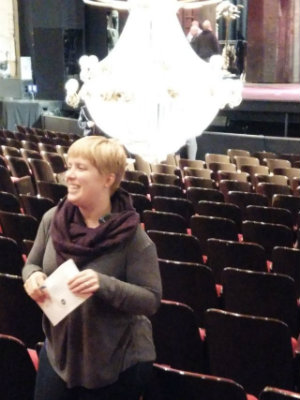
Sure, Miss Saigon has its helicopter; Nixon in China, Air Force One; Little Shop of Horrors, a giant man-eating plant; Show Boat, its life-size riverboat, etc., but who has the biggest, most dangerous flying chandelier of them all?
Just about everyone knows the answer — it's Phantom of the Opera — but for the few who have not seen Andrew Lloyd Webber's musical, here's a spoiler (so if necessary, skip a paragraph or two): The revenge of the Phantom is to crash the chandelier into the audience at the end of Act 1, and down it comes over the heads of audience in the center of the first 5-6 rows, stopping (here comes the spoiler!) about 10 feet up. That's the plan.
But how many have actually inspected the lethal object, covered up during most of Act 1? And so, I eagerly took up the invitation from the Orpheum Theater where the musical is playing through Oct. 4 — not for a backstage visit, but to inspect The Thing as it was being prepared in an empty theater, well before the performance.
As stagehands and pyrotechnic specialists worked on the chandelier, the touring company's no-nonsense but jovial stage manager, Heather Chockley, ran through the impressive statistics: it weighs a ton, has its own special truck, has over 6,000 beads, was designed by Howard Eaton, who was responsible for the Olympic rings in the London ceremonies.
And what of the scene under the chandelier? This current touring version has a lot going for it — including Paul Brown's set and Maria Björnson's costumes — but there is something rather strange in Laurence Connor's direction and the response of the cast. The duality of Phantom is in the exaggerated, mock pomposity of "grand opera" segments contrasting with the more realistic — although romantic/phantasmagorical — story of the musical.
What I saw at the Orpheum seemed reversed: "opera" was impressive, even through amplification; the romantic story stylicized, exaggerated, "operatic" in a pejorative sense... and the text difficult to understand due to singing without sufficient care for diction.
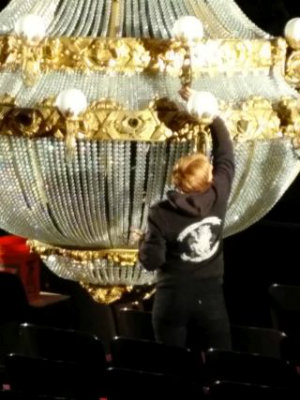
The supposedly mock-opera singers in Hannibal sound great; for example, Jacquelynne Fontaine as Carlotta, the screeching diva hated by the Phantom, in fact sings beautifully, against all odds. A tenor and a baritone are impressive. The locally-hired orchestra does well under the direction of Dale Rieling. And, of course, there is all that spectacular action.
But back to chandeliers, there is something special about the beautifully simple one at the War Memorial (also used as the logo for the San Francisco Opera), which may warm the cockles of the Bernoullian hearts. The chandelier's show-opening action has been going on for many years, and still few people know about it. If you don't want to wait until the next performance in the Opera House or if it happens too quickly to observe, ever-helpful SFCV saved a video of it, shot by Suzanne Turley.
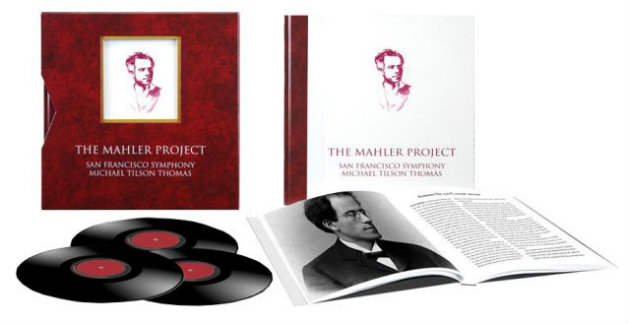
Ultimate Musical Retro: The Return of Vinyl
It's hard to believe after all the painful and expensive transitions from beta to cassettes to minidiscs to VCRs to CDs to DVDs to streaming, but ancient vinyl records — declared dead some three decades ago — have suddenly returned with a vengeance. Although once faced with the burden of disposal for what had appeared as musical debris, some music lovers persisted in championing "records" — somehow finding a working turntable and replacement stylus — and apparently their day has come.
Reports say that last year 13 million LPs were sold in the U.S. alone. For the nostalgia-challenged, LP stands for "long play," as in 33 1/3 Revolutions per Minute vs. the more ancient 45 RPM and 78 RPM records (the latter had an impossible, frustrating 4 minutes of music per side).
"The vinyl boom," reports the New York Times, "has come as streaming has taken off as a listening format and both CDs and downloads have declined. The reasons cited are usually a fuller, warmer sound from vinyl’s analog grooves and the tactile power of a well-made record at a time when music has become ephemeral."
Not only has vinyl returned, but about half of the customers are under 35 years of age. A Nielsen report says LPs represent almost 10 percent of sales of music in physical formats (will minidisc return? I sure hope so). In one of the more striking statistics, independent recording companies now get as much revenue from LPs as they do from CDs.
Here comes the local angle: I remembered San Francisco Symphony's recording of the Mahler Project five years ago on luxury LPs (with price to match: $749.99 for the 22-piece box set), so I tried to find out the place of that venture in the current vinyl resurrection. S.F. Symphony Director of Public Relations Louisa Spier had the answer:
While the S.F. Symphony Store has competely sold out of all the Mahler vinyl sets we had in stock, they still carry the Mahler box set on SACD for $175. For those interested in acquiring the collection on vinyl, Elusive Discs carries the complete vinyl box set.
Conducted by Michael Tilson Thomas, the seven-time S.F. Symphony Grammy® award-winning Mahler Recording Project included all Mahler symphonies and vocal works. The discs were pressed on 180-gram virgin vinyl in a limited edition of 1,000 copies.
Explaining esoteric references to the media: "normal" vinyl ranges from 120 to 140 grams, 180g is audiophile grade, thicker and heavier so it may warp less over time. "Virgin" is pure: it contains no recycled plastic, which can include impurities leading to a noisier record.

